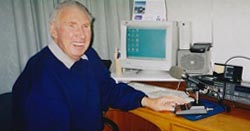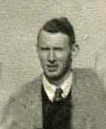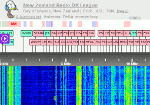My great dx hobby
Radio became my life in the 1930s when my parents had a mantle Oxford set and in 1939 purchased a Philips 650 6 valve allwave radio. I became hooked on listening to shortwave and medium wave. I joined the New Zealand DX Club and it was not long before I began sending out reports. Then the war came along but it did not stop DXing although I was to lose some reports through enemy action when ships were sunk or countries were captured. Even so the return of veries was about 90 percent, that changed later. As a result of growing interest I reformed the Otago branch which was in recess and we had about seven members. In those days Arthur Cushen and I would exchange weekly letters and keep informed of our activities.
One day I was asked to go into the radio inspectors office (I worked in the Telegraph Office) where I met two men who asked me to set up and organise a system to monitor enemy shortwave broadcasts and report on any mention of New Zealand and New Zealanders. They were members of the Security Intelligence Service. I arranged with Otago members and Arthur to carry out this assignment. It turned out to be an important part of the war effort by Dxers. (See Arthur Cushen’s “Secrets of Wartime Listening to Enemy Broadcasts”) I was in the Army Divisional Signals and then the RNZAF in the Pacific, and for a short period attached to an United States Navy flying boat squadron communications. This allowed me to continue monitoring. I obtained a battery operated Gulbranson 7 tube allwave set when in the army which I lugged around various camps. At Riccarton (Christchurch) I had my own hut out in the in middle of the racecourse to do the monitoring and DX ! I took up writing to next-of-kin of New Zealand Prisoners of War in Germany after hearing someone I knew, and on leave I proposed a monitoring system to our branch. At the same time Arthur Cushen was doing similar work and thus evolved the well known and successful Prisoner of War Monitoring Service which Arthur controlled passing on messages to families. An estimated 6000 messages were received. The service also ran during the Korean War.
Up the Islands I was in Air Force signals and was able to use radios such as the RCA AR88s and made a number of loggings. My letters back to Dxers in NZ telling what I was logging were censored by officers who did not understand what the callsigns meant so my friends would get a Dear……………. 73 Jack type. I found medium wave DX to the United States very good especially from Fiji.
After the war interest in Dxing grew and the Otago branch became a strong one with more than 20 or so members meeting monthly in a city hall. It played a strong role in the community such as getting sport results and news to daily newspapers and radio stations well ahead of the news services. Most noteable being the All Blacks tour of South Africa in 1949, and this is a story on its own in which Arthur Cushen played a part by making arrangements with the Radio Club of Mozambique to broadcast results ahead of the cable services. But it was the first test in which Otago created the biggest upheaval. Knowing the difficulties of getting signals from South Africa, due to the path through the South Magnetic Pole and that the South African Broadcasting Corporation had no shortwave transmitters, the League offered its assistance. It was declined by the New Zealand Broadcasting Service as it had its own receiving station at Makara. Neverthless Dxers monitored the official tests which were to prove beneficial. On the day of the first test Ken Mackey was approached by 4ZB to set up a station at his Long Beach crib as the staffers did not have confidence in their own Wellington operation !
A primitive wire recorder was installed and with most of New Zealand listening, the first half came in strong through Makara, but for the second half Wellington played music while the southerners were receiving perfect copy. Excitement was high at the crib as the music continued to be heard. The recording was raced back to Dunedin and Wellington ordered 4YA on the air so it could be played and be rerecorded for broadcast later in the morning. The uproar which blew up over this after the media had “learnt” that the NZBS had turned down the Dxers, offer ended up with the director general going to Dunedin and arranging for the relay of future games through the assistance of the Dxers. New Eddystone sets were flown down and as there was only one telephone line to Long Beach it was extended to Ken Mackey’s location and the Port Chalmers telephone exchange kept open all night to relay the broadcast so it could be fed into the net. (It is interesting to note that Ken’s 1936 Patterson radio performed better against the communications set).
When the first postwar cricket match took place in Australia between the MCC and Australia, Radio Australia introduced ball-by-ball broadcasts. This was something new and with one of New Zealand’s leading radio shops (Columbus Radio Centre) and Otago Dxers combined in a big operation. A large scoreboard was set up in their Dunedin shop and we would feed in results. When conditions were suitable we would set up a listening post in the window which created such interest that the crowd packed out onto the street that traffic officer had to control people so trams could get past. Olympics and others followed and we were regularly headlines in the papers. Weekly New Zealand Dxers Calling were broadcast over 4XD and the branch was also involved in producing the first callbook for some years which went on sale in the country and overseas.
DX FRIENDSHIPS
South Island Dxers had strong friendships and became concerned about the national headquarters in Auckland. A meeting between the southerners led to an ultimation being given that unless the hobby returned to its proper function a new DX organisation would be formed. Thus we have the New Zealand Radio DX League which was born in 1949. Leading up to the formation saw Otago and Southland Dxers plan for the basis of the new organisation with the southern branch responsible for the monthly New Zealand DX Times and Dunedin the administration. Today we have an organisation that has led to being one of the most recognised DX groups in the world.
In the late forties and fifties Otago Dxers turned their attention to Long Beach where Ken Mackey had a holiday home and George Beardsmore established one. This, along with Murray Lamont’s location at the Spit near the entrance to Otago Harbour, the former proved to be one of the country’s best DX locations. Beverage aerials were erected on manuka stakes 10 or so feet above the sandhills to the beach at lengths of 1000 feet and more. These highly directional antennas would bring in low power Americans on medium wave with no trouble. Monday nights would see Dxers travel some 20 miles over a rough road from Dunedin and spend a few hours chasing 100 and 250 watts undertaking frequency checks with the FCC. The 50.000 watters would be “ignored” as 250 and 1000 watters were the catches sought. European and Asian stations were also excellent DX areas in the early mornings.
OUR FIRST CONVENTION
Otago launched the first DX Convention when it was held in 1955 at Long Beach which was attended by a large number of Dxers, a year later saw 23 at Riverton Rock for the”Antarctic Touch”. Many others have followed throughout New Zealand and even attract people from overseas.
Now, many years later I have not lost my enthusiasm for radio and still enjoy my time listening to stations around the world but no longer send reports. In 1993 I gained my amateur license and spend time on air Dxing. If I was asked had things changed ? Oh yes they have, let’s look at shortwave. In the thirties the stations were more entertaining with music but the war brought along propaganda and in the Cold War period wide spread jamming. Thankfully most of this has gone. In those days when you heard a station you knew it was located on in its own land, not today, and added to this was that a station was identified by its callsign. Each country had its own and every frequency had its own call.
What was my favourite station over the years? I would have to say Radio Australia in its heyday. The BBC and Radio Nederland have also been high in my stakes. There have been others, perhaps it is strange but monitoring Berlin during the war led me to become a fan of German music and I now have a large collection.
What has the hobby done for me? Besides giving me a terrific amount of enjoyment it broadened my knowledge of so many countries, but it did much more like giving me experience in developing organisational skills for future years. It was radio that changed my life when I took up journalism and founded a prize winning newspaper. It all began through writing DX and radio notes in newspapers.
Yes, DX through radio, has been a great hobby for me and one which I have never had a regret of being associated with through the many people I have met and known. It has been and is still a great hobby. I hope to able to continue for many more years.
FROM MY LOG BOOK
The following are some shortwave stations I logged during World War 2. Those
marked with * were sent a reception report which were verified after the war.
KZRH 9640 1000 Manila WCAB 9590 10000 Philadelphia WRUW 15130 10000 Boston WRCA 9670 25000 New York
PLP 11??? 1500 Bandoeng VPD2 9535 400 Suva
CSW7 9740 Lisbon JZJ 11.800 50.000 Tokio
XGOY 11895 Chungking FFZ 12005 400 Shanghai
SVM 9935 Athens ZHP 9700 400 Singapore
MTCY 9545 20000 Hsinking SUX 7865 5000 Cairo
(Manchucia, now part of China) HVJ 6190 15000 Vatican *
TPZ 12120 Algiers OFE 11780 Helsinki
ZBW3 9525 2400 Hong Kong EQB 6155 14000 Teheran
CR6AA 7177 1000 Lobito, Angola KGEI 9670 50000 San Francisco
FZF6 9705 1600 Fort-de-Framce XEDN 11760 Shanghai
French Guinea COCO 8700 Havana
R Saigon 6190 Saigon, French Indo FK8AA 6140 Noumea
China
CNR2 8035 25000 Rabet, Morocco HCJB 9890 10000 Quito
R. Leopoldville 11720 Belgium Congo JCJC 7220 Jerusalem
FZI 11970 Brazzaville, French Congo VQ7LO 10730 600 Narobi
Vichy National 11840 Vichy, Unoccupied France* ZOH 4880 Colombo
R Dakar 11405 Dakar HER5 11960 25000 Berne
AFN (GRR) 6080 50kw London SEAC 11810 Kandy, Ceylon
ABSIE 6230 London CKCX 15190 50000 Sackville
(American Broadcasting Station in Europe)
Footnote:
Members will be very saddened to learn of the death of our club’s patron and foundation Vice President on 1 October following a serious stroke on 21 September. Jack was particularly excited about attending the DX League’s 60 th anniversary celebrations in North Otago on 4 October, but regrettably this was
not to be. His funeral was held in Mosgiel that morning, and the anniversary programme was deferred so that members could attend the funeral. Ross Gibson, Barry Williams, Bryan Clark, David & Jo Ricquish, David Miller, Jim Searle and Pat Beardsmore, widow of the late George Beardsmore, represented DXers at the funeral. Bryan Clark paid tribute to Jack on behalf of League members and delivered flowers to his wife Anita.
Another speaker spoke of Jack’s amateur (ZL4WND) and CB interests. As a further tribute to Jack, his 2001 article “My Great DX Hobby” is reprinted elsewhere in this 60 th anniversary edition of the NZ DX Times. Just last month, Jack’s article “Amazing War Effort By A Small Group” was posted at the www.ontheshortwaves.com website, in the “DX History/POW Monitoring” section.”
Growing up in the 1930s depression, Jack never attended high school but always
aspired to be a journalist. Self-taught, he eventually founded the Taieri Herald in
1962, and this newspaper continues today as his legacy, as does the DX League
which he helped to found. Jack’s wise counsel, enthusiasm and sense of humour
will be greatly missed by the League.
The following profile was scanned from the February 1952 DX Times:
Our Second President: JACK F. FOX, of 9 Mulford Street, Concord,
Dunedin, was president of’the NZRDKL in 1949-50. He first became interested in DX in 1939 when he purchased an NZDXC call-book and VLR Melbourne on short waves was.his first verification, dated December 9, 1939. Jack is interested in DX on both broadcast and short wave and has 502 verifications on broadcast and 548 on s.w. He considers his first call of importance as Radio Maroc (11940) heard in Invercargill on June .6, 1940.
Prized as his most interesting QSL’s are GKFX(6080) 10 watts and first N.Z. report, Quimper France(832), BZS(2495} Campbell Islands, while at his present location he has added some worthwhile Yank catches on b.c. He was third in the recent world Listening contest on s,w. The receiver in use is a prewar British Philips while he is also interested in a “Bill Marsh” radio. He has beverage antennas strung across gullies. In private life Jack is a Clerk we believe in the radio section of the Post And Telegraph Department, while during the war he served with Divisional Signals(arm ), RNZAF Signals, and U.S. Communications, Flying Boat Squadron 17 attached at Segend, New Hebrides. He states he has DXed at Ashburton, Westerfield, Riccarton Racecourse, Wanganui, Nausori in Fiji, New Hebrides, Invercargill and Dunedin. His main hobby is DX but is interested in gardening…a case of having to be as he was married early in 1949 and is now the father of Beverley Verna, born on August 23, 1951. Jack is red-headed, well over six-foot tall and 29 years old. he has always been keenly interested in the administrative side of DX. He revived the Otago Branch of the NZDXC in August, 1940, was the first secretary and has held most positions in the branch, including president for many years. He formed the first.DX monitoring post of enemy stations during the war under instructions from the N.Z. Government and founded the Prisoner-of-War monitoring service during the World War. Jack has been a member of the Board of Directors of the NZRDXL since its formation and at council table he always produces several weighty matters for discussion and his presentation of the facts shows careful and thoughtful preparation.





